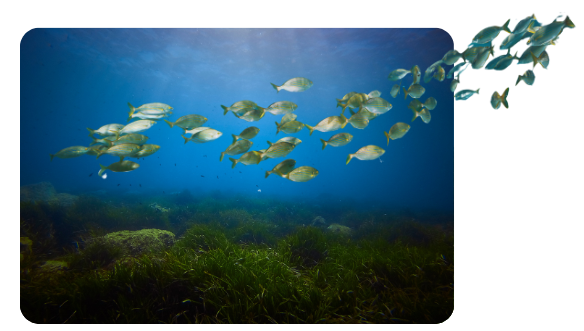Project
ACTOM Decision Support Tool

Project Start: January 2019 | Project End: December 2023
Project Funder: Accelerating CCS Technologies, The Research Council of Norway, Netherlands Enterprise Agency, Department for Business, Energy & Industrial Strategy, Department of Energy, United States America
Principal Investigator: Dr Jerry Blackford
Project Website: https://www.pml.ac.uk/projects/ACTOM
About ACTOM
The ACTOM Decision Support Tool enables operators of offshore geological carbon storage sites to plan effective environmental monitoring, whilst minimizing cost. The toolbox enables the operator to explore different sensitivity thresholds and determines an optimal sensor deployment strategy, based on local hydrodynamics and seabed features. The DST can quantifiably assess that a proposed monitoring strategy delivers an acceptable standard of assurance for stakeholders.
The toolbox can be applied to any offshore shelf sea site and uses generic algorithms driven by readily available site-specific information. The toolbox is coded using a docker container enabling its use on multiple computational platforms.
The DST can:
- Enable regulators to quantifiably assess that a proposed monitoring strategy delivers an acceptable standard of assurance.
- Enable operators to properly plan, cost and adapt monitoring strategies to site specific circumstances, hence accelerate the planning phase and implementation.
- Enable regulators and operators to communicate to the effectiveness of proposed monitoring strategies to enable informed societal consensus in view of marine spatial planning.
Access DST
Access to the documentation and code
The Decision Support Tool is open source and can be freely downloaded from https://github.com/ACTOMtoolbox , which also includes documentation. It is compatible with Windows, Linux and Mac OS. If used independently the developers accept no liability relating to the use of the DST.
The toolbox developers, an academic / R&D consortium based in the UK, Norway, Netherlands and US would be delighted to discuss providing a service using the toolbox, please contact one of:
- UK: Jerry Blackford jcb@pml.ac.uk
- Norway: Guttorm Alendal Guttorm.Alendal@uib.no
- NL: Stefan Carpentier stefan.carpentier@tno.nl
- USA: Katherine Romanak, katherine.romanak@beg.utexas.edu and/or Rajesh Pawar, rajesh@lanl.gov
The github page will have a register option with the following: We would be grateful if you could register your interest in the DST. All details will be kept on a secure system and not shared with third parties. This helps us track and report on (anomalously) the uptake of the tool to our various funding agencies
Publications
- Report on regulations and technological capabilities for monitoring CO2 storage sites. S. E. Schütz, A. Omar, and S. Carpentier, ACTOM project web site, Jan. 2021. https://actom.w.uib.no/files/2021/01/ACTOM-D1-1-report.pdf (accessed Jul. 14, 2022).
- Demonstration of how understanding natural variability of CO2 chemistry in the specific marine system is vital to optimise anomaly criteria, illustrating the use of the “Rate-of-Change” criteria. J. Blackford, Y. Artioli, J. Clark, and L. de Mora, “Monitoring of offshore geological carbon storage integrity: Implications of natural variability in the marine system and the assessment of anomaly detection criteria,” Int. J. Greenh. Gas Control, vol. 64, pp. 99–112, Sep. 2017, https://doi.org/10.1016/j.ijggc.2017.06.020
- A demonstration of how advanced statistical techniques can optimise the placement of sensors over a storage site. P. W. Cazenave et al., “Optimising environmental monitoring for carbon dioxide sequestered offshore,” Int. J. Greenh. Gas Control, vol. 110, p. 103397, Sep. 2021, https://doi.org/10.1016/j.ijggc.2021.103397 .
- Showing how Machine learning Techniques can be used to plot the optimal path of autonomous underway mounted sensors to detect leakage. G. Alendal, “Cost efficient environmental survey paths for detecting continuous tracer discharges,” J. Geophys. Res. Oceans, vol. 122, no. 7, pp. 5458–5467, 2017, https://doi.org/10.1002/2016JC012655 .
- An introduction to the ACTOM DST concept as presented at GHGT-15. J. Blackford et al., “A Toolbox to Assist in Designing Marine Monitoring Programs for Offshore Storage Sites,” Social Science Research Network, Rochester, NY, SSRN Scholarly Paper ID 3821572, Apr. 2021. https://doi.org/10.2139/ssrn.3821572 .
- Case studies using the ACTOM DST as presented at GHGT-16 G.Alendal et al., The Impact of Pre-Project Data Quality and Quantity on Developing Environmental Monitoring Strategies for Offshore Carbon Storage: Case Studies from the Gulf of Mexico and the North Sea. GHGT-16.
- Using a high-resolution multiphase model to characterize accidental releases. M. Dewar et al., “Analysis of the physicochemical detectability and impacts of offshore CO2 leakage through multi-scale modelling of in-situ experimental data using the PLUME model,” Int. J. Greenh. Gas Control, https://doi.org/10.1016/j.ijggc.2021.103441
- An introduction to the ACTOM DST approach to characterizing accidental relaeases as presented at GHGT-14. A. Oleynik et al., “Simplified Modelling as a Tool to Locate and Quantify Fluxes from a CO2 Seep to Marine Waters,” Social Science Research Network, Rochester, NY, SSRN Scholarly Paper ID 3366076, Apr. 2019. https://doi.org/10.2139/ssrn.3366076
- A demonstration of the stoichiometric “CSEEP” methodology to identify CO2 anomalies. A. M. Omar et al., “Detection and quantification of CO2 seepage in seawater using the stoichiometric Cseep method: Results from a recent subsea CO2 release experiment in the North Sea,” Int. J. Greenh. Gas Control, vol. 108, p. 103310, Jun. 2021, https://doi.org/10.1016/j.ijggc.2021.103310 .
- A documentation of the carbonate chemistry routines used in the ACTOM DST. M. P. Humphreys et al., “PyCO2SYS: marine carbonate system calculations in Python.” Zenodo, May 18, 2022. https://doi.org/10.5281/zenodo.6560756 .
- This paper establishes a basic rule that links the rate of any hypothetical CO2 release into seawater to its detectability and impact potential in terms of distance, area and volume: J. Blackford et al., “Impact and detectability of hypothetical CCS offshore seep scenarios as an aid to storage assurance and risk assessment,” Int. J. Greenh. Gas Control, vol. 95, p. 102949, Apr. 2020, doi: 10.1016/j.ijggc.2019.102949. https://doi.org/10.1016/j.ijggc.2019.102949
Figures
Animation of the evolution of the region where anomalies may be detected (threshold -0.01pH) for a hypothetical scenario

Recommended placement of stationary sensors sufficient to capture a pH change of 0.01. The number within each symbol shows the number of hypothetical release sites that each sensor is able to monitor.
A detailed graphic showing the information flow within the toolbox
Project Funded By
  |
 |
|
 |
 |
Project Partners
 |
 |
 |
 |
 |
 |
 |
 |



